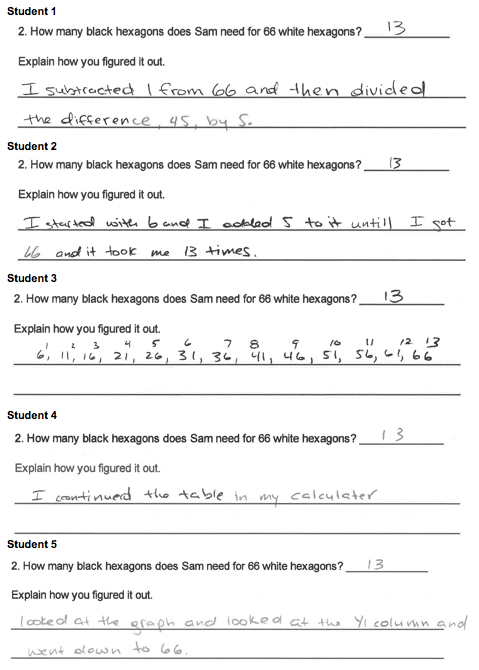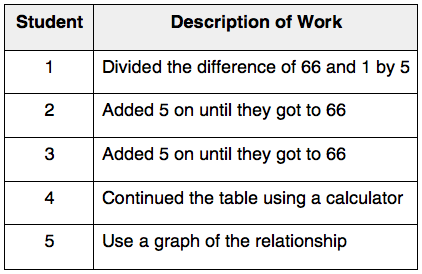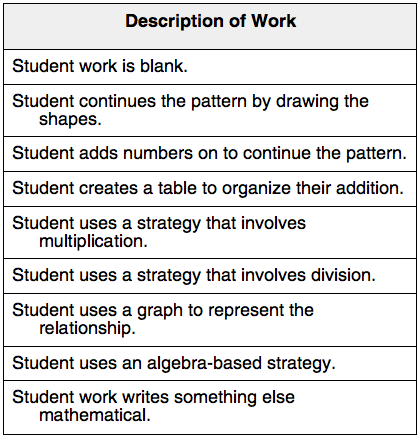By David Wees, Posted June 8, 2015 –
In the previous post, I argued that the numbers that result
from scoring student work compress a lot of important information that could
potentially help you plan a lesson. In this post, I outline a simple protocol
to categorize the student work
instead of merely scoring it.
Start by looking through all your student
work and take notes on what kinds of strategies students are using. For
example, the five samples of student work below are from the same task I shared
last time, Patchwork Quilt. Look at the student work and
decide what strategies the students are using.

Here’s how I categorized these five
examples, but it is by no means prescriptive. You should categorize student
work in ways that are meaningful and useful to you.

In this particular sample, all the
students were successful at this task in different ways, and student 2 and
student 3 were the most similar. In a larger, less selective sample of student
work, we would expect a much wider variety of strategies and answers. To produce
the most useful categorization of work, try to create categories that include
students from a broad range of performance levels in each category and avoid
categorizations that resemble “successful kids” in some groupings and “unsuccessful
kids” in other groupings.
With this in mind, I revise and broaden
each of the categories. I also include more information about the type of
thinking that students are doing and less about how successfully they answered
the question. I want to look through more than five samples of work. When I do,
I might end up with the categories in the table below.

One caveat here: Just because a student
choses a particular strategy for solving a particular problem does not mean
that he or she does not know other strategies for solving the same kind of
problem. Paying attention to general trends over time is important.
Additionally, recognize that some of
the strategies seen in student work are somewhat hierarchical. Students who add
numbers on to continue the pattern may be abstracting from continuing to draw
the pattern. Students who use a division strategy may be aware that they could
use multiplication to solve the same kind of problem.
Once the categories are set up, go
through the rest of the student work and assign each student’s work to one category.
In ambiguous cases, select a category that you think will be most helpful in
making decisions, perhaps based on this idea of a hierarchy within the
strategies. Focus on one specific and critical question from within a larger
task, in this case, question 2 from the Patchwork Quilt task, so that you aren’t
overwhelmed with the amount of work. In some cases, this may mean looking
through the entire task and selecting a category that is based on all the
different strategies that students used for similar questions.
In my next post, I will discuss how we
can meaningfully use this categorized student work in a couple of different
ways.
 David Wees, [email protected], is a Formative
Assessment Specialist for New Visions for Public Schools in New York. He tweets
at @davidwees and blogs at http://davidwees.com.
David Wees, [email protected], is a Formative
Assessment Specialist for New Visions for Public Schools in New York. He tweets
at @davidwees and blogs at http://davidwees.com.